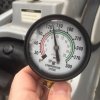NautiqueJeff
New Member
2001 GTX DI - Won't Run Over Idle Speed
2001 GTX DI -- It starts up and idles great. When you first start it and accelerate, it will run above idle for a minute or two, but will never rev above about 30%. After a couple of minutes, it gets very difficult to keep it running at all above idle. It just stalls when you give it gas. It will run seemingly all day at idle speed though.
If you shut it down and let it sit for a minute or two, it will fire right back up and accelerate to about 20% before stalling out again. If you start it and let it idle, it will continue to run.
Very rarely, if you give it full throttle, it will slowly accelerate, occasionally popping briefly into normal running for a few seconds (hard acceleration, good speed), but only for a few seconds, and I have only been able to get it to do this maybe two or three times during my 30-minute test run yesterday.
I just replaced the fuel pump and sock filters with the proper unit from High Flow. The old pump was very rusty and the filters were completely falling apart. I also drained and cleaned the tank and added fresh gas. I was really hoping this would fix the issue. It did not.
I also replaced the voltage regulator.
I did not replace the inline filter.
It is running exactly the same as it did before I replaced the fuel pump, sock filters and regulator.
Any suggestions on what to check next?
2001 GTX DI -- It starts up and idles great. When you first start it and accelerate, it will run above idle for a minute or two, but will never rev above about 30%. After a couple of minutes, it gets very difficult to keep it running at all above idle. It just stalls when you give it gas. It will run seemingly all day at idle speed though.
If you shut it down and let it sit for a minute or two, it will fire right back up and accelerate to about 20% before stalling out again. If you start it and let it idle, it will continue to run.
Very rarely, if you give it full throttle, it will slowly accelerate, occasionally popping briefly into normal running for a few seconds (hard acceleration, good speed), but only for a few seconds, and I have only been able to get it to do this maybe two or three times during my 30-minute test run yesterday.
I just replaced the fuel pump and sock filters with the proper unit from High Flow. The old pump was very rusty and the filters were completely falling apart. I also drained and cleaned the tank and added fresh gas. I was really hoping this would fix the issue. It did not.
I also replaced the voltage regulator.
I did not replace the inline filter.
It is running exactly the same as it did before I replaced the fuel pump, sock filters and regulator.
Any suggestions on what to check next?
Last edited by a moderator:








